Halcyon Days in the Dream City
by Mrs. D. C. Taylor
Continued from Part 8

Pause, before you enter, and gaze upon this mighty mass of crystal and iron;[1] union of purity and strength, seemingly so frail and airy, and yet in reality so firm and stable. Look at the roof, like a huge translucent wave, at the grand majestic archways towering high above you, with their pictured allegorys [sic] smiling down upon you from their airy heights.[2] Step within this arch and look through the doorway down the long, long perspective, where human beings dwindle away to moving black dots. Comprehend, if you can, the vastness, the richness, the illimitable variety of these productions of every clime and nation of the globe. Pace slowly down the grand central aisle and tell us what you see.[3] But no! we will set you no such impossible task, for well we know the very soul would faint before its magnitude. Forty-four acres of exhibits, think of it, if you can.
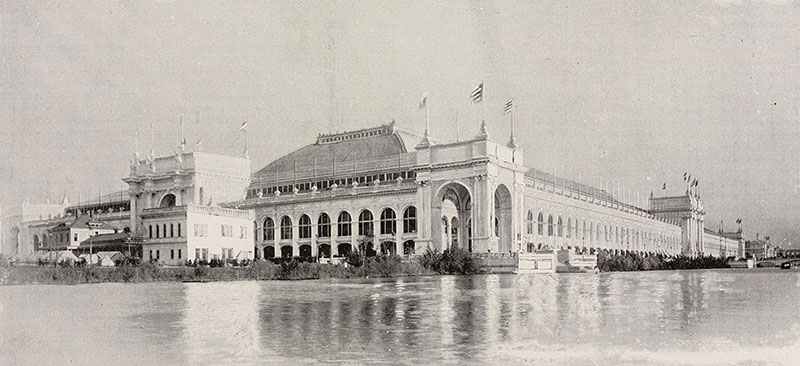
Manufactures and Liberal Arts Building at the 1893 World’s Fair, as seen from the Wooded Island. [Image from The Graphic History of the Fair. Graphic Co., 1894.]
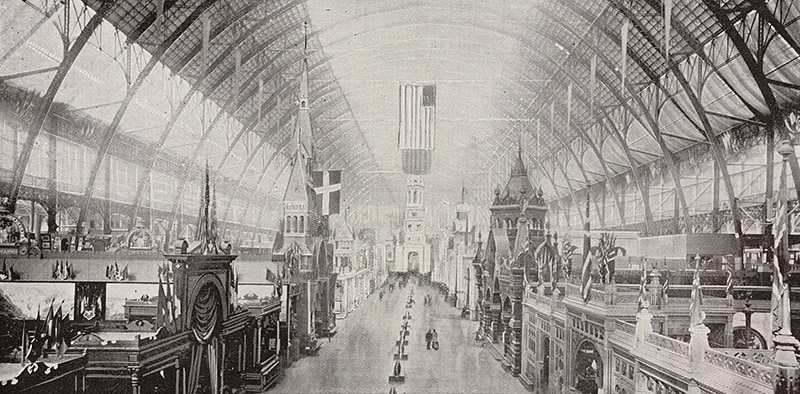
A view looking north along Columbia Avenue in the Manufactures and Liberal Arts Building. The grand Tower Clock of the Self-Winding Clock Company can be seen in the distant center. [Image from The Graphic History of the Fair. Graphic Co., 1894.]
Look about you again. To the right lies the exhibit, of Germany. The great lace-like iron gates are open and we step into a bewildering array of works of art in gold, silver, bronze, and most of all in Dresden china. Every conceit that ever tricksy sprite suggested, carried out in that material; huge vases covered with laughing cupids peeping out from behind wreathed flowers; mirrors, large and small, framed in the same; tables, dishes, cups, all in the same style of florid gayety; the profusion is so bewildering once ceases to admire. Let us pass on. Here is a throne room, with its mirrored and gold embroidered walls, its chairs of painted satin, framed apparently in solid gold, its jeweled roof and gilded candelabra; its doors are carved in precious woods, and marbles costly as gems lend their pallor to offset the profusion of gold and glitter. Take but a glance; pass on.
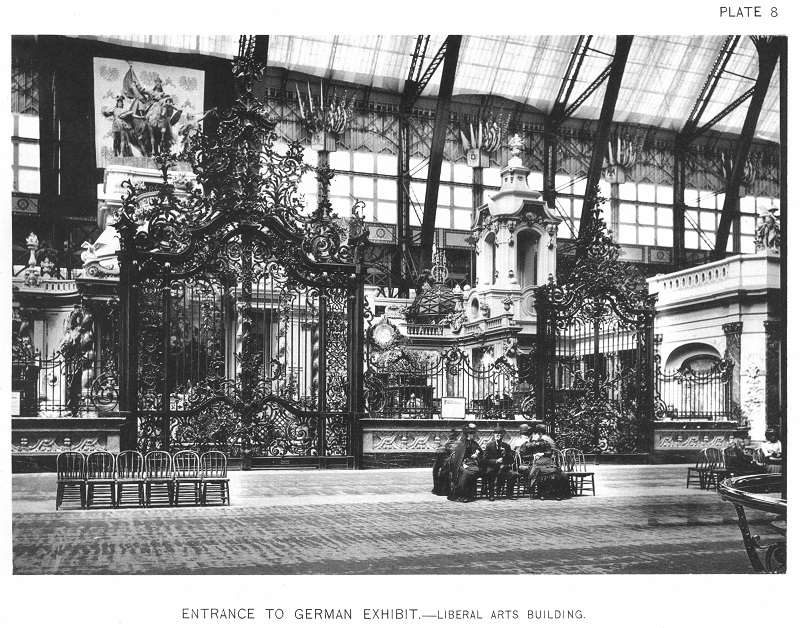
Entrance to German Exhibit in the Manufactures and Liberal Arts Building, [Image from Official Views of the World’s Columbian Exposition by Arnold, C. D.; Higinbotham, H. D. 1893.]
The great bear rears his huge length and strength of limb above a group of satellites, that all wear costly coats of fur. Here we catch the blue of Lapis Lazuli, the green of Malachite, the streaked splendor of the Onyx. Here the gloom of grand dark carvings in oak and mahogony [sic]. Here are some dresses for noble ladies, stiff and ungraceful in their gold embroidery and satin sheen, and here are the petticoats and aprons of the peasant girls, thickly ornamented with painful cross-stitch in blue and red cotton; queer head gear, like glorified pots and pans, and laces so coarse in thread and mesh, that they are heavy in weight as if made of metal. No sympathetic harmony of form or color here; nothing soft and alluring, but cold, hard, brilliant, pass on.
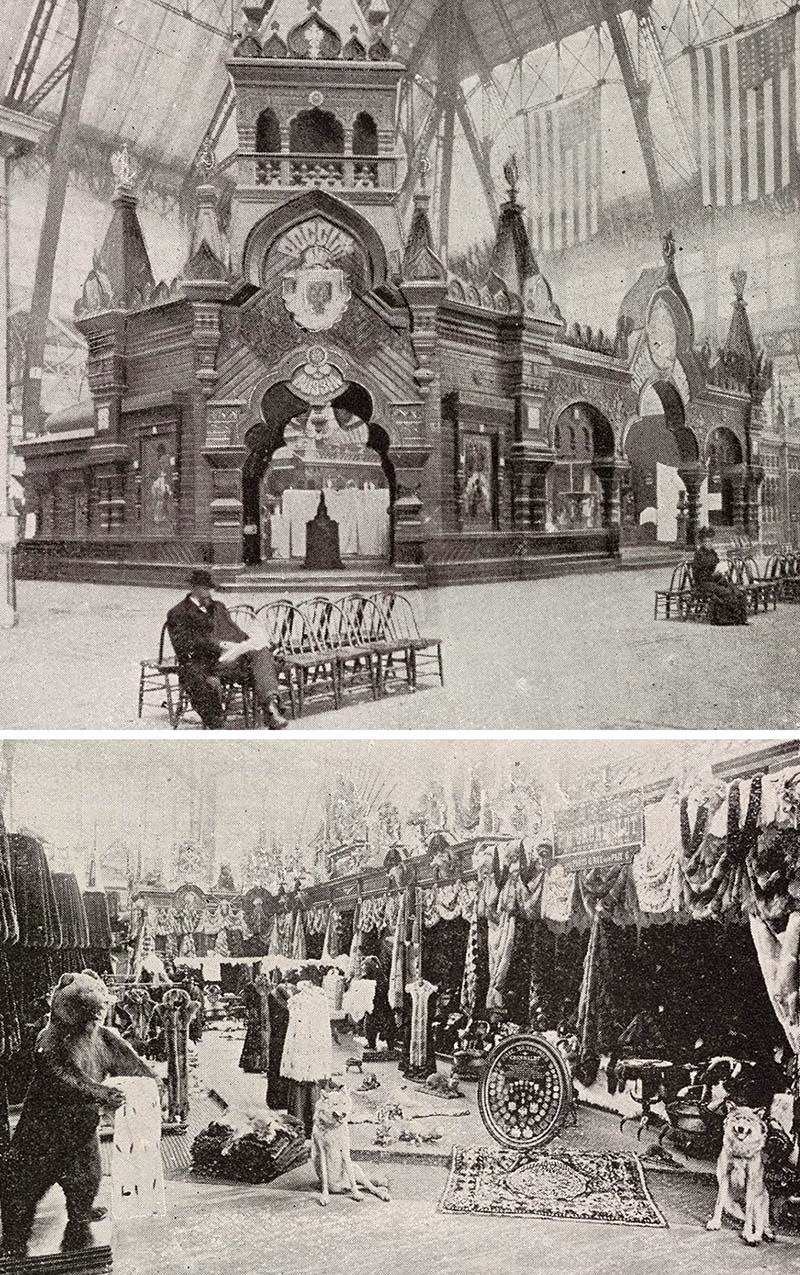
The facade of Russian Pavilion inside the Manufactures and Liberal Arts Building. [Image from The Graphic History of the Fair. Graphic Co., 1894.]
Arch beyond arch oft repeated, red and white, red and white; yellow and black banners, fans, fans, fans! delicate trinkets filagreed [sic] in gold and silver. Laces, lovely Spanish laces! who has not heard the magic words? We feel every moment as though we must hear the tinkling of a guitar, and the voice of a Caballero serenading his ladylove! Oh! here she is! dark eyed and sweet (selling fans.) What a pretty little gay flowered muslin skirt she wears, giving glimpses of high-heeled red morocco slippers, what a trim little, laced red velvet bodice, and bust modestly covered with a white lace fichu showing only the round brown throat encircled by gold beads. The smooth dark cheeks the soft dark eyes, the satin dark hair coiled so queerly on either temple stabbed through with long gold pins, and the high topped comb, immensely high and broad! that gives the finishing touch to the picture. Here she is! the Spanish Donna of our dreams, and lovelier than those dreams ever painted her! we stand and gaze, and gaze until she glances uneasily from beneath her long dark lashes; then we remember that she is alive, and apologetically buy a fan and pass on—for Spain has no more charms for us, we have seen her crowning flower.
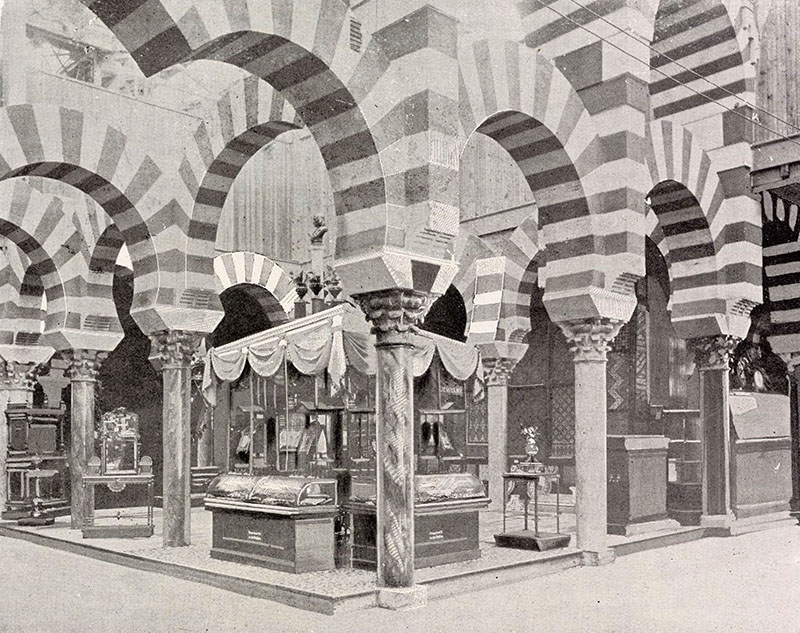
The Moorish arches of the Spanish section of the Manufactures and Liberal Arts Building. [Image from The Graphic History of the Fair. Graphic Co., 1894.]
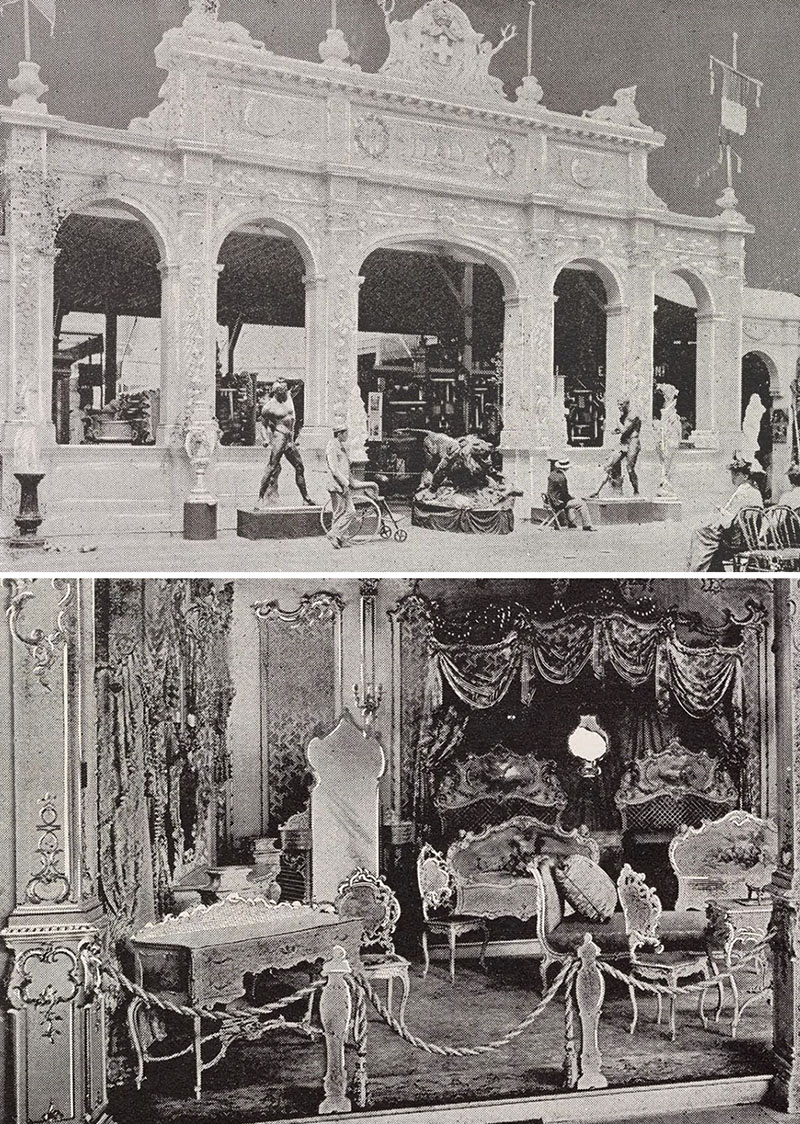
The facade of the Italian Pavilion inside the Manufactures and Liberal Arts Building. [Image from The Graphic History of the Fair. Graphic Co., 1894.]
NOTES
[1] The largest building in the world at the time of the fair, the Manufactures and Liberal Arts Building designed by George Post was 787 feet by 1,687 feet, with approximately 40 acres of floor space inside and covered by a massive roof over 312 ft. high made of iron and glass.
[2] The allegorical paintings “smiling down upon you from their airy heights” refers to the murals decorating the domes and timpana of each of the grand entrances to the Manufactures and Liberal Arts Building.
[3] The “grand central aisle” was the fifty-foot-wide Columbia Avenue that ran the north-south length of the main floor.
[4] The “tower, apparently of whitest marble” is the magnificent Clock Tower that rose 120 feet above Columbia Avenue in the center of the building. The clock was manufactured by the Self-Winding Clock Company.
[5] The chiming clock had nine bells fitted with hammers and magnets to be struck by electrical signals. The chimes could be played automatically at predetermined times by means of clock mechanism, or by an operator sitting at a keyboard.
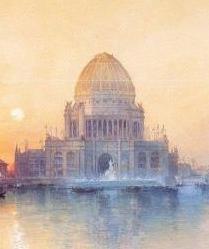
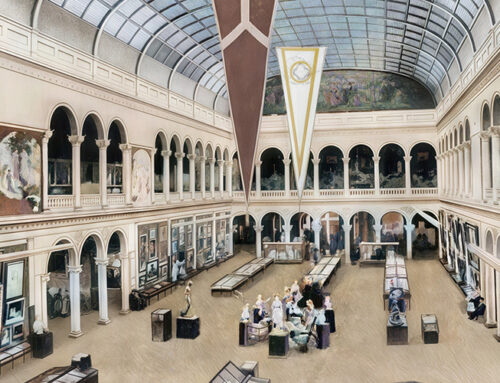
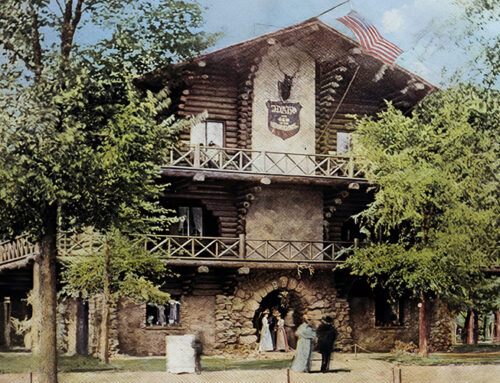
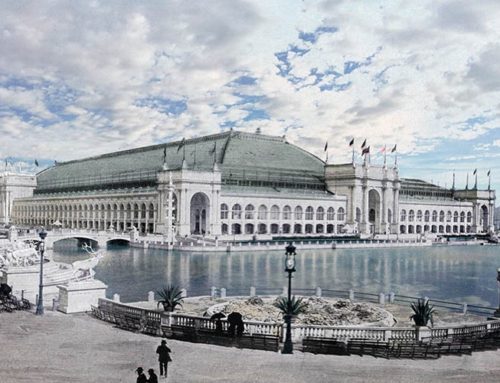
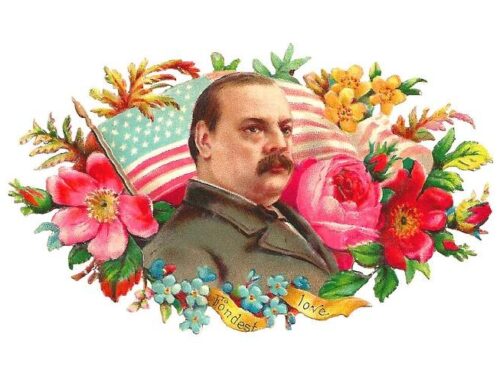
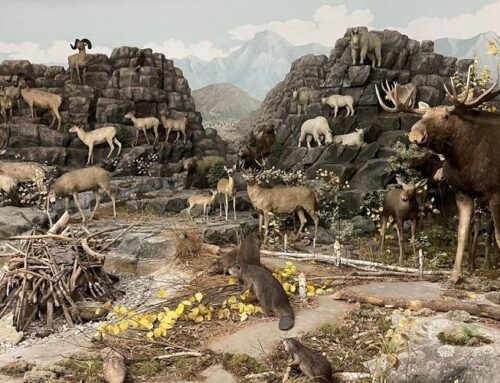
Leave A Comment